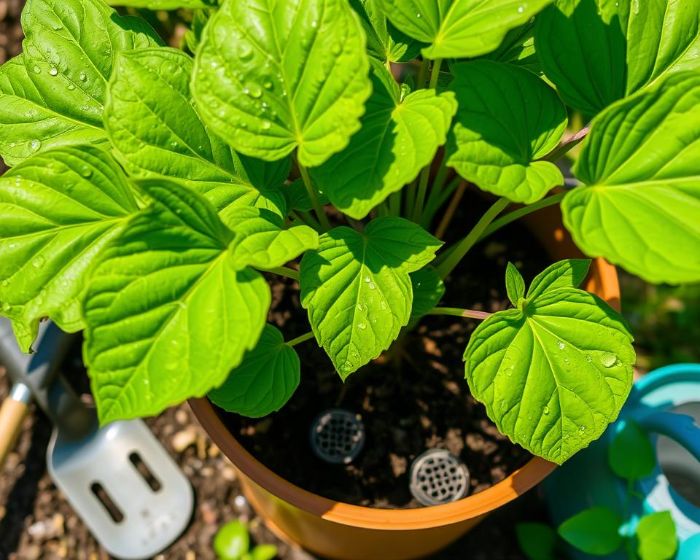Are your garden plants not looking as vibrant and healthy as they should? Could underwatering be the culprit behind their lackluster appearance? To understand if your plants are suffering from insufficient water, it’s crucial to recognize the signs of underwatering. By learning these indicators, you can take the necessary steps to revive your plants and ensure their continued growth and vitality.
Key Takeaways:
- Underwatering can cause wilting leaves and dry, cracked soil.
- Plants that are underwatered may have stunted growth and increased susceptibility to pests and diseases.
- Checking for underwatering involves simple tests to assess soil moisture levels and recognizing specific signs in different plant types.
- Corrective measures for underwatered plants include proper watering techniques and understanding when and how much to water.
- Preventing underwatering requires establishing a watering schedule and choosing the right soil and containers for improved water retention.
Table of Contents
Key Symptoms of Underwatered Plants
Recognizing the symptoms of underwatered plants is essential for maintaining the health and vitality of your garden. Two key symptoms to look out for are wilting leaves and lack of turgidity.
Wilting Leaves and Lack of Turgidity
One of the most obvious signs of an underwatered plant is wilting leaves. When plants do not receive enough water, their leaves may appear droopy and lose their firmness. The lack of water causes the cells in the leaves to lose their turgidity, resulting in a wilted appearance.
In addition to wilting, you may also notice that the leaves feel limp and lack their usual strength. This lack of turgidity is a clear indication that the plant is not receiving adequate water to support its growth and development.
Dry Soil and Root Exposure
Another indicator of an underwatered plant is dry soil surrounding the plant. When the soil lacks sufficient moisture, it becomes dry and cracked. This dryness can be observed by visually inspecting the soil around the plant or by feeling the soil with your fingers.
In severe cases of underwatering, the roots of the plant may become exposed to the air. This can occur when the soil has become extremely dry and unable to retain enough moisture for the roots to absorb. Root exposure is a critical symptom that requires immediate attention to prevent further damage to the plant.
To help you visualize the symptoms of underwatered plants, take a look at the image below.
Now that you are familiar with the key symptoms of underwatered plants, it’s important to address the issue promptly. In the next section, we will explore the consequences of continuous underwatering and the measures you can take to revive and prevent underwatered plants.
The Consequences of Continuous Underwatering
Continuous underwatering can have negative consequences on garden plants. When plants do not receive enough water, their growth can become stunted. Without sufficient hydration, plants fail to reach their full potential, resulting in stunted growth. This can be observed through the lack of height, smaller overall size, and underdeveloped foliage.
In addition to stunted growth, underwatered plants also experience reduced resilience. They become more susceptible to environmental stresses such as high temperatures, extreme weather conditions, and nutrient deficiencies. These plants are unable to withstand these challenges as effectively as properly hydrated plants, causing them to suffer and potentially perish.
The lack of sufficient water also weakens the overall health of plants, making them more vulnerable to pest infestations and diseases. Underwatered plants are commonly at risk of attracting pests and developing diseases due to their weakened state. These weakened plants struggle to fend off the attacks of insects, mites, and other pests. Furthermore, their compromised immune systems make them more susceptible to fungal, bacterial, and viral infections.

It is crucial to address underwatering promptly to ensure the health and vitality of garden plants. By providing adequate water and hydration, gardeners can promote optimal growth, strengthen plants’ resilience, and reduce susceptibility to pests and diseases. Recognizing the consequences of underwatering plants is key to cultivating thriving and resilient gardens.
How to Check for Underwatering
Checking for underwatering is an important step in maintaining the health of your plants. By assessing soil moisture levels and recognizing signs in different plant types, you can ensure that your plants are getting enough water to thrive.
Simple Tests to Assess Soil Moisture Levels
There are a few simple tests you can perform to assess the moisture levels in your soil. One method is to stick your finger about an inch into the soil. If it feels dry at that depth, it may indicate that the plant is not receiving enough water. Another option is to use a moisture meter, which can provide more accurate readings.
Recognizing Signs in Different Plant Types
It is important to recognize the specific signs of underwatering in different plant types, as the symptoms may vary. Some common signs to look out for include wilting leaves, dry soil, and root exposure. However, it’s worth noting that different plants may exhibit different indicators of underwatering. Familiarize yourself with the specific needs and characteristics of your plants to accurately identify signs of underwatering.
By regularly checking soil moisture levels and being attentive to the signs of underwatering, you can promptly address any issues and provide your plants with the proper hydration they need to thrive.
Corrective Measures for Underwatered Plants
Taking corrective measures for underwatered plants is crucial to ensure their health and vitality. Implementing proper watering techniques is the key to reviving these plants and promoting healthy growth.
Proper Watering Techniques
When it comes to watering underwatered plants, it’s essential to water them thoroughly and evenly. Ensure that the water reaches the roots by watering directly at the base of the plants. This allows the roots to absorb the moisture they need for optimal growth.
In addition, consider using a watering can or a drip irrigation system to deliver water directly to the roots. This method helps prevent water waste and ensures that the plants receive the proper amount of moisture.
When and How Much to Water
Knowing when and how much to water your plants plays a crucial role in addressing underwatering. The timing of watering depends on various factors, including the plant type, weather conditions, and soil moisture levels.
As a general rule, it’s best to water in the early morning or late evening when the temperatures are cooler. This helps minimize water evaporation and ensures that the plants have enough time to absorb the water before the heat of the day.
The frequency of watering will vary depending on the specific needs of different plants. To determine when to water, check the moisture levels of the soil. Stick your finger into the soil about an inch deep. If it feels dry at that depth, it’s time to water. However, if the soil feels slightly moist, it’s best to wait and check again later.
Keep in mind that factors such as the plant’s stage of growth, humidity levels, and the type of soil will also influence how much water the plants require. It’s important to strike a balance between providing enough moisture without overwatering, as this can lead to other problems like root rot.
By following proper watering practices, gardeners can help revive underwatered plants and prevent future occurrences of underwatering. When in doubt, always prioritize the specific needs of your plants and monitor their response to watering to ensure their overall health and well-being.

Preventing Underwatering – Best Practices
Preventing underwatering is crucial for maintaining the health and vitality of garden plants. By implementing best practices in garden care, you can ensure that your plants receive the right amount of water they need to thrive. Here are a few essential tips to help you prevent underwatering:
Establishing a Watering Schedule
One of the key steps in preventing underwatering is establishing a watering schedule tailored to the specific needs of your plants. Different plants have different water requirements, so it’s important to understand the watering needs of each variety you have in your garden. Consider factors such as plant type, size, weather conditions, and soil moisture levels to determine the frequency and duration of watering. By following a consistent watering schedule, you can provide your plants with adequate moisture to prevent underwatering.
Choosing the Right Soil and Containers for Improved Water Retention
The type of soil and containers you use can play a significant role in preventing underwatering. Opt for a well-draining soil mix that retains moisture while allowing excess water to drain away. Adding organic matter to the soil can improve its water retention ability. Additionally, consider using containers with built-in drainage holes to prevent waterlogging and root rot. Proper soil and container selection can help ensure that your plants have access to sufficient moisture, reducing the risk of underwatering.
Implementing these best practices in your garden care routine can go a long way in preventing underwatering and promoting healthy plant growth. By establishing a watering schedule based on your plants’ needs and choosing the right soil and containers for improved water retention, you can create an optimal environment for your plants to thrive.
Conclusion
Recognizing the signs of underwatering in garden plants is crucial for their healthy growth. By understanding the symptoms and taking proactive measures, gardeners can prevent the negative consequences of underwatering and ensure that their plants receive the proper moisture to thrive.
Implementing proper watering techniques is essential in addressing underwatering. By watering the plants thoroughly and evenly, ensuring that the water reaches the roots, gardeners can help revive underwatered plants and promote their vitality.
In addition to proper watering, following preventative measures is key to preventing underwatering. Gardeners should establish a watering schedule based on the specific needs of the plants and choose the right soil and containers that promote improved water retention. These practices will help maintain the resilience and vitality of garden plants and ensure successful plant cultivation.
FAQ
What are the signs of underwatering in garden plants?
The signs of underwatering in garden plants include wilting leaves and lack of turgidity. The leaves may appear droopy and lose their firmness. Additionally, the soil around the plant may become dry and cracked, with the roots exposed to the air.
What are the key symptoms of underwatered plants?
The key symptoms of underwatered plants are wilting leaves and lack of turgidity. The leaves may appear droopy and lose their firmness. Additionally, the soil around the plant may become dry and cracked, with the roots exposed to the air.
What are the consequences of continuous underwatering?
Continuous underwatering can lead to stunted growth and reduced resilience in garden plants. Underwatered plants also become more susceptible to pests and diseases.
How can I check for underwatering?
You can check for underwatering by performing simple tests to assess soil moisture levels. This can be done by sticking a finger into the soil or using a moisture meter. It’s also important to recognize the specific signs of underwatering in different plant types.
What corrective measures can I take for underwatered plants?
To revive underwatered plants, you should implement proper watering techniques. This includes watering the plants thoroughly and evenly, ensuring that the water reaches the roots. It’s also important to know when and how much to water, considering factors such as plant type, weather conditions, and soil moisture levels.
How can I prevent underwatering?
To prevent underwatering, establish a watering schedule based on the specific needs of the plants. Choose the right soil and containers that promote improved water retention, ensuring that the plants have access to sufficient moisture.
Why is it important to recognize the signs of underwatering?
Recognizing the signs of underwatering is essential for the healthy growth of garden plants. By understanding the symptoms, implementing proper watering techniques, and following preventative measures, you can ensure that your plants receive the adequate moisture they need to thrive.










